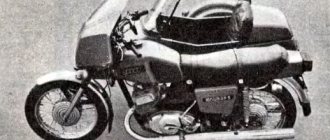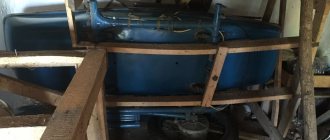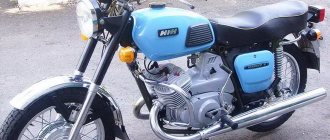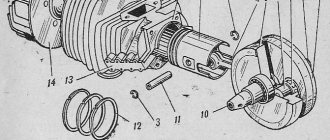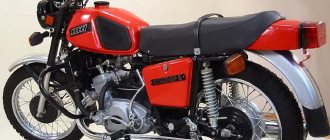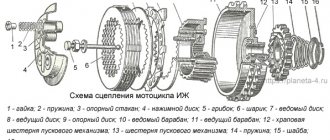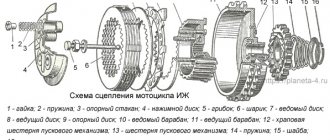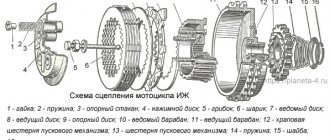home
In 1961, an Izhevsk motorcycle called Jupiter was released. A new family of IZH Jupiter has appeared. The design is similar to the IZH-56 motorcycle produced earlier. Its significant difference is the installation of a two-cylinder engine. In addition, some changes have been made to the clutch, gear shift device and electrical equipment.
Motorcycle IZH Jupiter technical characteristics
Total information
Motorcycle type - single Base, mm - 1360 Ground clearance, mm - 135 Dimensions, mm: Length - 2115 Width - 780 Height - 1025 Saddle height - 780 Motorcycle dry weight, kg - 160 Maximum speed, km/h - 110 Fuel tank capacity , l — 15 Fuel consumption rate on the highway, l/100 km — 4 Fuel range, km — 375 Filling oil capacity, l: gearbox housing — 1 of each front fork leg — 0.15 rear suspension elements (two) — 0 .12 air purifiers - 0.2
Motorcycle IZH-Jupiter technical characteristics engine
Engine type - two-stroke with two-channel return purge Number and arrangement of cylinders - two, vertical in-line Cylinder diameter, mm - 61.75 Piston stroke, mm - 58 Displacement, cm cubed - 347 Compression ratio - 6.7 - 7.0 Maximum power, l. With. — 18 Number of revolutions at maximum power, rpm — 4700-5100 Tax power, n. pp. - 1.33 Cylinder head: material - aluminum alloy combustion chamber shape - hemispherical Gasket material - rayasbestos Piston: material - aluminum alloy shape - convex Number of piston rings - 3 Piston pin (type) - floating Piston pin diameter, mm - 14 Protection against axial displacement - with stoppers. Valve timing, in degrees of crankshaft rotation: beginning of intake to c. m.t. - 75° end of intake after c. m.t. - 75° start of release to c. m.t. - 80° end of release after n. m.t. - 80° start of blowing after n. m.t. - 58° end of blowing after n. m.t. - 58° Engine lubrication - oil with gasoline Carburetor - K-28Zh Air cleaner - contact-oil Fuel filter - mesh in the sump
Power transmission
Clutch - multi-plate in an oil bath Gearbox: type - four-speed control - foot gear ratios: in first gear - 3.17 in second gear - 1.71 in third gear - 1.26 in fourth gear - 1 Total gear ratio (from the engine to the rear wheel): in first gear - 18.98 in second gear - 10.24 in third gear - 7.54 in fourth gear - 5.89 Forward gear: type - roller chain gear ratio - 2.57 Rear gear: type — roller chain gear ratio — 2.63 Chassis Frame — tubular, non-separable welded Front fork — telescopic with hydraulic shock absorbers Rear suspension — lever spring with hydraulic shock absorbers Tires: type — straight-bezel size in inches — 3.25-19 Brakes — shoe brake drive — mechanical separate
Ignition, electrical equipment
Ignition system - battery Battery battery: brand - 3-MT-7 capacity, a-h - 7 voltage, V - 6 Generator: brand - G36M2 voltage, V - 6 power, W - 45 Drive - the generator is mounted on the right axle of the crankshaft engine Regulator relay - two-stage Ground connection terminal - minus Signal - S-37 Headlight - FG-38
Planet 5
It was also produced by the Izhevsk Machine-Building Plant from 1987 to 2008.
Main advantages:
- The engine is “high-torque” Planet 5 is compared to a tractor, it has such good engine traction.
- No ignition problems.
- Not high fuel consumption.
- Compared to Jupiter 5, repairs are even easier.
Characteristics:
- Weight - 158-165 kg
- Engine – two-stroke single-cylinder, 22 hp
. - Cooling is air.
- The maximum speed is 120 km/h.
- Fuel consumption - 5-6 liters
.
Main disadvantages:
- Starter kickback to the leg. There were cases when a foot was broken.
- Unpleasant vibration. It's like sitting on a massager.
- Sound when working. It looks like it's about to fall apart.
Now both motorcycles can be bought on the market, the cost ranges from 5 to 50 thousand rubles
. Both models were produced in limited quantities with water cooling; they are now more difficult to obtain. Liquid cooling reduces fuel consumption and reduces noise levels.
Engine IZH Jupiter
In 1961, an Izhevsk motorcycle called Jupiter was released. A new family of IZH Jupiter has appeared. The design is similar to the IZH-56 motorcycle produced earlier. Its significant difference is the installation of a two-cylinder engine. In addition, some changes have been made to the clutch, gear shift device and electrical equipment. At the front of the crankcase there are two crank chambers, and at the rear there is a gearbox. The crank chambers are closed with covers and each of them contains crankshafts on ball bearings, which are protected from axial displacement by retaining rings. The crankshaft axle shafts are sealed with oil seals. Under the left crankcase cover mounted on a gasket, the front chain drive, clutch and trigger mechanism are located. The crankshafts are connected to each other by an external flywheel. The generator rotor and the breaker cam are installed on the axle cone of the right crankshaft. The generator housing is mounted on the crankcase. The engine pistons are connected to the crankshaft connecting rods using piston pins, which are protected from axial displacement by retaining rings. The engine cylinders have aluminum jackets and cast iron liners. The cylinder heads are made of aluminum alloy and are attached together with the cylinders to the crankcase with studs.
Motor part
The motor part of the engine consists of a cylinder-piston group, a crank mechanism and a crankcase group.
Motor part of IZH Jupiter: 1 – generator cover; 2 – right crankcase cover; 3 – generator; 4 – right seal with cover; 5 – right crankshaft; 6 – right half of the crankcase; 7 – flywheel; 8 – crankshaft seal; 9 – crank chamber cover; 10 – left crankshaft; 11 – left seal; 12 – left half of the crankcase; 13 – crankshaft sprocket; 14 – left crankcase cover; 15 – cylinder; 16 – cylinder head; 17 – piston; 18 – spark plug; 19 – connecting rod; 20 – hairpin.
Engine parts IZH Jupiter
Engine parts: 1 – cylinder pipe; 2 – cylinder gasket; 3 – left cylinder; 4 – hairpin; 5 – left cylinder head; 6, 12 – washers; 7 – nuts; 8 – retaining ring; 9 – piston; 10 – piston ring; 11 – left cheek of the crankshaft; 13 – connecting rod; 14 – right cheek of the crankshaft; 15 – flywheel; 16 – bushing; 17 – piston pin; 18 – crankshaft; 33 – flywheel mounting bolt; 34 – crank pin; 35 – needle bearing.
Clutch
Located on the left side of the engine in an oil bath. Closed with a lid with a gasket to prevent oil leakage. The main thing that can be said when assembling the coupling. Some conditions need to be met. The first compression spring nuts should protrude 3.5 - 4.0 mm above the caps. This will save the disks from distortion. Tighten the second adjusting screw until it stops. Then loosen 1/4…1/2 turn. Essentially this is a clutch adjustment.
Details of the Izh Jupiter clutch: 19 – bracket with lever; 20 – outer clutch drum; 21 – pusher; 22 – ball; 23 – thrust rod; 24 – inner clutch drum; 25 – clutch drive disk; 26 – driven disk; 27 – pressure disk; 28 — cap; 29 – spring; 30 – shaped nut; 31 – adjusting screw; 32 – nut.
IZ Jupiter clutch diagram
The clutch of the IZH-Jupiter motorcycle differs from the clutch of the IZH-56 motorcycle by the installation of a ball bearing and an adjusting screw 31 with a lock nut 32.
Trigger
The starting mechanism is designed to start the engine. Has no adjustments. The parts are simply assembled in the right position and that’s it. During operation, worn parts are replaced with new ones. The gears and sector are the first to fail - inspect the teeth.
Starting mechanism of the IZH Jupiter motorcycle: 1 - washer; 2 — trigger pedal; 3 - roller; 4 — pedal axis; 5 - ball; 6 — clamp spring; 7 - clamp; 8 - bolt; 9 — reflector; 10 - cuff; 11 — kickstarter shaft; 12 - sector; 13 - spring; 14 — washer; 15 - ring; 16 — washer; 17 — spring; 18 - gear.
Gear shift mechanism
It is located inside the gearbox and the control lever is on the left side of the engine. It has changed the drive device of the shift sector and forks, which operate directly on the worm shaft. If the switch does not work properly. Disassemble the engine and wash all switching parts and check for wear and chips. Replace faulty ones.
IZ Jupiter gear shift mechanism: 4 – shift pedal; 25 – spring of the gear shift mechanism; 26 – gear shift sector; 27 – mechanism leash; 28 – shaft; 32 – worm shaft; 33 – fork for switching second and fourth gears; 34 – fork for shifting first and third gears; 36 – clamp spring; 37 – neutral contact post; 38 – neutral contact flag; 39 – switching anchor.
Transmission
The gearbox of the IZH-Jupiter motorcycle on the IZH-Yu motorcycle is the same as on the IZH-56 motorcycle and differs only in the design of the switching mechanism. Basic care is checking the oil and replacing it in a timely manner.
IZ Jupiter gearbox diagram: 1 – input shaft; 2 – secondary shaft; 3 – intermediate shaft; 4 – support ball bearings of the shafts; 5 – roller bearing of the secondary shaft; 6 – gearbox gears; 7 – secondary shaft oil seal; 8 – asterisk.
Engine diagram
Diagram of the engine block with gearbox, clutch and generator: 1 – spark plug; 2 – cylinder head; 3 – cylinder; 5 – piston; 6 – piston ring; 7 – bypass channel; 8 – piston pin; 9 – bushing of the upper head of the connecting rod; 10 – connecting rod; 11 – left crank chamber cover; 12 – drive sprocket; 13 – ball bearing; 14 – oil seal; 15 – left crankshaft axle shaft; 16 – roller bearing of the lower head of the connecting rod; 17 – crank pin; 18 – clutch spring; 19 – hatch cover; 20 – clutch adjusting screw; 21 – clutch pressure plate; 22 – inner drum; 23 – gear shift pedal; 24 – trigger pedal; 25 – left crankcase cover; 26 – clutch discs; 27 – outer clutch drum; 28 – trigger mechanism sector; 29 – spring; 30 – trigger gear; 31 – ball bearing; 32 – left half of the crankcase; 33 – gear shift fork; 34 – gear shift roller; 35 – gear shift sector; 36 – gear shift mechanism roller; 37 – fastening pin; 38 – right half of the crankcase; 39 – right cylinder head; 40 – right cylinder; 41 – flywheel; 42 – right crank chamber cover; 43 – cylinder gasket; 44 – right oil seal; 45 – generator; 46 – right crankshaft axis; 47 – right crankcase cover; 48 – generator cover; 59 – breaker cam; 50 – central anchor mounting bolt; 51 – asterisk; 52 – oil seal; 53 – roller bearing; 54 – secondary shaft; 55 – oil seal; 56 – input shaft; 57 – clutch release rod; 58 – clutch release lever; 59 – sprocket mounting nut; 60 and 61 – gearbox gears; 62 – clutch cable cam; 63 – clutch cam; 64 – spring.
Repair and tuning
The products of the Izhevsk plant have never been famous for their reliability. But there is also an advantage in this - being the first motorcycle for a novice biker, some “Izhak” acted as a “learning desk”, helping to learn not only driving, but also independent maintenance and repair.
Repair
Gearbox causes complaints
. It works clumsily, and problems sometimes arise with it, as with the clutch. Another weak point that often requires attention is the valves, the clearances of which must be carefully monitored. The Izh Jupiter 5 engine likes to “kill” them if the gaps are not adjusted in time. Fortunately, with this motor this procedure is relatively simple.
Spare parts
Finding them is not difficult, because at one time the Izhevsk plant riveted a fair number of motorcycles. The prices are low, but in some cases it is cheaper and easier to buy a “donor”, from which you can remove everything you need as needed.
Tuning
It is not easy to somehow modify a Soviet bike. Typically, owners reduce all changes made to visual tuning. Sometimes the carburetor is replaced with a Japanese or Chinese one - this relatively inexpensive operation helps avoid many potential problems.
Electrical equipment of the IZH Jupiter motorcycle
The electrical equipment of the IZH Jupiter motorcycle differs only in the installation of the G-36M2 generator.
Electrical diagram of the IZH Jupiter motorcycle:
1 — rear light; 2 — neutral lamp switch; 3 - central switch; 4 — neutral indicator lamp; 5 — speedometer lighting lamps; 6 - main lamp; 7 — parking light lamp; 8 — light switch; 9 — sound signal; 10 — brake light switch; 11 - candle; 12 — control lamp; 13 - fuse; 14 - battery; 15 — relay-regulator; 16 - generator; 17 - capacitor; 18 - breaker; 19 - ignition coil.
Motorcycle IZH Jupiter K with an increased gear ratio in reverse gear. The drive sprocket is installed with a smaller diameter and fewer teeth. The presence of a stroller forced the manufacturer to increase the torque, but reduce the speed to 80 km/h.
Design
It would be naive to expect design delights from Soviet motorcycles. The bike looks similar to all other models produced by motorcycle factories of those years, but this is not surprising - the fifth generation was developed on the basis of the fourth, and the fourth - on the basis of the third, created back in the 70s of the last century. But many bikers, nostalgic for the old days, appreciate this rugged simplicity. Moto Izh Jupiter 5 does not stand out in any way externally from other bikes from the times of the USSR, which you can easily see for yourself by looking at the photo.
Comparisons and differences
Jupiter 5
- This is a livelier motorcycle with good throttle response. In terms of comfort, it is head and shoulders above its opponent. The two-cylinder engine is more powerful and faster in speed. According to the passport, the speed is 125 km/h, but it’s realistic to reach 150 km/h only after engine repairs are provided. The ignition is not stable and causes many problems. Fuel consumption is considered high.
Planet 5
- this is a steam locomotive, it has a decent torque, but when you press the throttle it reacts very sluggishly.
Gears are switched with over-throttle. But the traction is head and shoulders above due to its torque, it’s like a tractor. Another difference is the absence of ignition problems
. Repairing it is even easier and cheaper. Fuel consumption is considered low.
What common
These are motorcycles that were a good help in the household. The cost in Soviet times was around 1000 rubles. Every adult resident of the union could afford them. Both models were intended for movement on all types of roads and off-road. They deservedly enjoyed it and are popular among motorcyclists.
Externally, both devices are very similar. The devices are simple and reliable to use. You can repair them yourself. It is possible to attach a cargo or passenger side trailer. The models were designed as an alternative to passenger cars. It should be noted that the designer completed the task. In terms of chassis, cladding and parameters, they are not very different. The main difference is the engine design. Both motorcycles were upgraded many times during production. They have several types of configurations.
